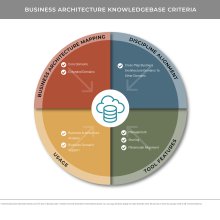Though the Winter Olympics may be over (sad face), we are still thinking about speed and business architecture. In our last installment, we looked at accelerating the development of a business architecture knowledgebase using reference models. StraightTalk Post No. 23 here will talk about how we can leverage tools for further acceleration.
How do tools support business architecture?
Business architecture tools allow you to capture, view, analyze, report on, visualize and share business architecture content in support of various business scenarios.
Remember way back when to Post No. 1? Here’s a refresher on how it works:
1. You document your organization’s business architecture in a knowledgebase (ideally in an automated one).
2. Now that you have lots of information in there, you create any type of blueprint (diagram) or report you want.
3. You apply those blueprints and reports to various scenarios. (This is the most important part.)
P.S. Posts No. 12 and No. 13 are also good refreshers on the core and extended domains of business architecture.
How do we know when we need to invest in a business architecture tool?
Many business architecture teams start with “VEP” (a.k.a. Visio, Excel and PowerPoint) as their business architecture tool. That is all well and good in the beginning—until you start capturing more content and cross-mapping it to each other. The cross-mapping part tends to be the tipping point as it can be challenging and time consuming to accurately ripple through all changes across various spreadsheets and Visio or PowerPoint diagrams.
Automated tools to the rescue. Having a tool to manage your business architecture knowledgebase is a critical investment. The business architecture knowledgebase needs to represent the full scope of your organization’s ecosystem and is the foundation of your practice. It is intelligence for decision-making, design and planning. It is a major factor which differentiates business architecture from other disciplines.
Most business architecture practices invest in a business architecture tool during their first or second year.
What do we look for in a business architecture tool?
A few things.
- Business Architecture Mapping – Ability to capture and maintain content for all of the business architecture domains, including the core domains (capabilities, value streams, organization and information) and extended domains (e.g. strategies, products, stakeholders, etc.).
- Discipline Alignment – Ability to cross-map business architecture domains to other domains (e.g. connect capabilities to requirements, processes and system applications).
- Usage – Ability to attribute and analyze the business architecture, such as by capturing and visualizing capability and value stream effectiveness through heat-mapping. Also includes the ability to create, analyze and visualize various deliverables in support of business scenarios (e.g. strategy translation, project portfolio management, etc.).
- Tool Features – A variety of features that allow you to manage and share business architecture. Also includes non-functional aspects such as usability, availability and security. Also includes alignment with the BIZBOK® Guide metamodel.
Here’s a diagram to visualize all of that:
Are there any other resources we can leverage to help us with business architecture tool selection?
Yep. The Business Architecture Guild® offers a Business Architecture Tool Evaluator® which provides a comprehensive set of BIZBOK® Guide-aligned evaluation criteria and allows you to assess, score and compare any tools that you are considering. The evaluator was created and tested by business architecture practitioners. (See More Good Stuff below for information on how to get your copy.)
What sort of business architecture tools are available?
There are a number of tools available ranging from lighter weight ones to more robust enterprise architecture tools. Some tools provide a full range of business architecture functionality, while some just support a portion of the domains and scenarios. (This is where the Business Architecture Tool Evaluator® can help you to make an informed choice.)
As the business architecture discipline continues to catch on globally, we will likely see more tool options available in the market and more alignment with the BIZBOK® Guide.
What are some key considerations as we evaluate tools?
Here are just a few things to keep in mind overall. Look for tools that:
1. Are BIZBOK® Guide-aligned—and not in a way that requires you to invest in a lot of expensive customization. A big part of this is having a BIZBOK® Guide-aligned metamodel.
2. Can easily migrate to another solution (e.g. if you start out with a lighter weight tool, you may want to move the data out of it to an enterprise architecture tool suite later).
3. Allow you to easily get the data out and share it in a consumable and visually appealing way.
Huh? What is a metamodel?
Very simply stated, a metamodel is a definition of the domains of business architecture and their relationships to each other (and to other domains outside of business architecture like for process and IT architecture). This may sound a bit technical, but the metamodel actually defines the scope of business architecture and how everything works together—which allows you to support all of those great business scenarios which provide value to your organization.
The Business Architecture Guild® is currently going through a process to standardize the metamodel in the BIZBOK® Guide. This very important work will pave the way for more consistency and alignment in business architecture tools in the future.
Anything else?
Keep in mind that you can and should start with a lighter weight tool as you establish your business architecture practice, knowing that you can always migrate to more robust ones later on. In addition, if you have IT architect counterparts in your organization, inform and consult with them on your tool choices. We are all part of the enterprise architecture umbrella, so a common vision and coordination across architecture disciplines is important.
More Good Stuff…
Business Architecture Tool Evaluator® (Business Architecture Guild®): You can download the tool evaluator from the store on the Business Architecture Guild® website (free for members; a steal for non-members).
Business Architecture Knowledgebase and Tooling Content (BIZBOK® Guide): Check out Sections 5.1 and 5.2 in the BIZBOK® Guide (Business Architecture Guild® membership required) for the official word on the business architecture knowledgebase and tooling. If you really want to geek out, check out the business architecture metamodel in Appendix B.4.
Acceleration trap: myths vs reality of speed (TED Talk): A TED Talk by Heike Bruch on why we are so “busy” and what creates the phenomenon of the “acceleration trap” which leads to stress, anxiety and burnout. Is your organization stuck in it?

